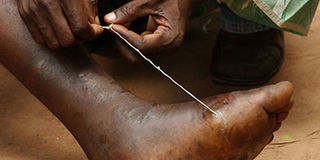Uganda stamps out Guinea worm disease

Since 1991, Uganda has been campaigning to eradicate the Guinea worm. 18 years later, the ancient parasitic disease has been completely eliminated from the country, according to the World Health Organisation, making it the second major disease after smallpox to be wiped out.
Guinea worm disease which is scientifically called dracunculiasis is a parasitic worm infection that has been endemic in African countries such as Uganda, South Sudan, Mali, Ghana and Nigeria. Health experts say the eradication of the disease will contribute to the reduction of the huge disease burden that the country still faces.
Costly parasite
According to Dr John Bosco Rwakimari, a former national coordinator for the Guinea worm eradication programme, treating the disease was costing the country up to $20m annually. “When we started interventions to fight the disease, we were spending $15m annually. In 1995, we intensified our campaign, drilling more than 2,000 at a cost of Shs15m in the affected areas,” Dr Rwakimari said.
Dr Peter Langi, the coordinator of the Uganda Guinea Worm Eradication Programme (UGWEP) said although the worm rarely kills, blisters that occur from the effects of the worm can result in secondary infections including long term disability. People get infected when they drink water containing flea that is infected with the larvae of the Guinea worm.
Worm symptoms
When in the body, the larvae matures and grows as long as three feet, and after one year, it emerges through a painful cancerous blister in the skin, causing long term pain and suffering.
“It starts with a swelling, then itching and a blister before the worm comes out. To get the worm out, you get a small piece of stick and roll the worm slowly out of the blister,” he explains.
Dr Langi said that while the process of removing the worm is easy, complications can sometimes arise when it breaks into two and fails to come out.
“Victims should not dare to speed the process of pulling out the worm because it may snap into two and the part left inside can cause permanent deformities,” he said.
To stop its spread, health workers teach affected people to stay away from contaminated water supplies. Water filters have also been distributed to the communities to be used to block water fleas from water sources. This is largely the strategy that has been used to eradicate the disease.
Dr Langi said in 1991, there were 126,369 cases of guinea worm reported in Uganda. The most endemic areas were Arua, Moyo, Kitgum, Kotido and Moroto.
But these figures continued reducing until they reached 316 by 1999 and to single digits by 2002. In the last six years, starting in 2004, no single worm was found to have infected a person, thus clearing the country of the disease.
“When the survey was done , we found that most of the heavily affected areas had low water coverage and the people who had the disease were not seeking medical treatment and because they kept using the same contaminated water sources, they were repeatedly infected,’’ Dr Langi said.




